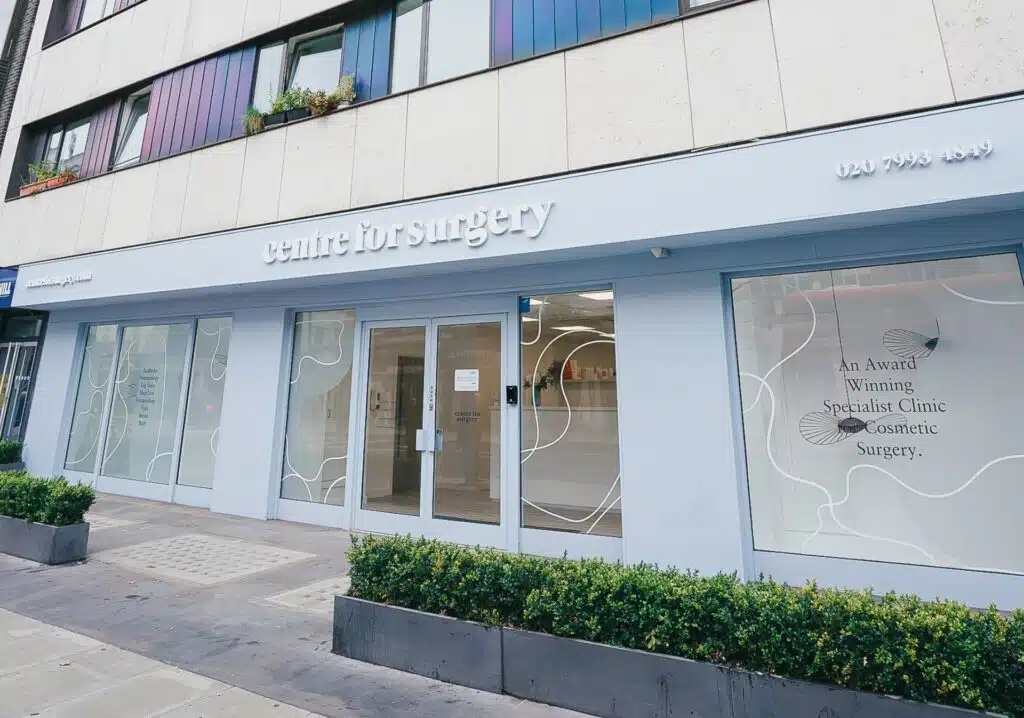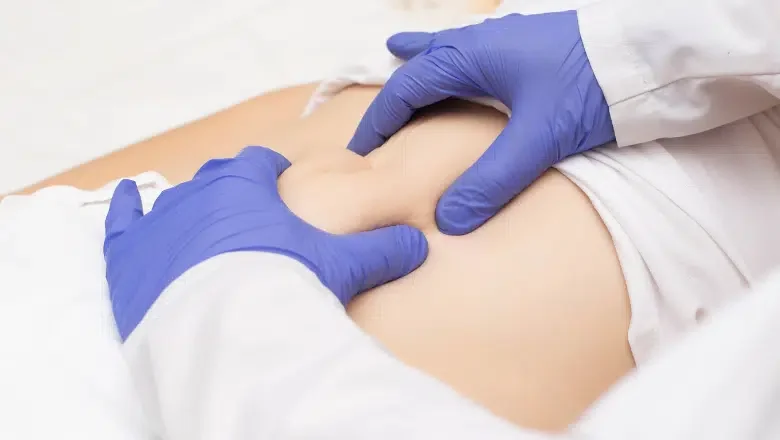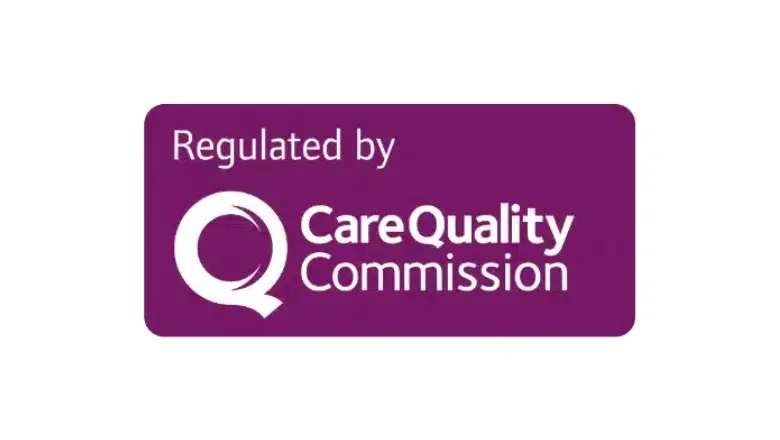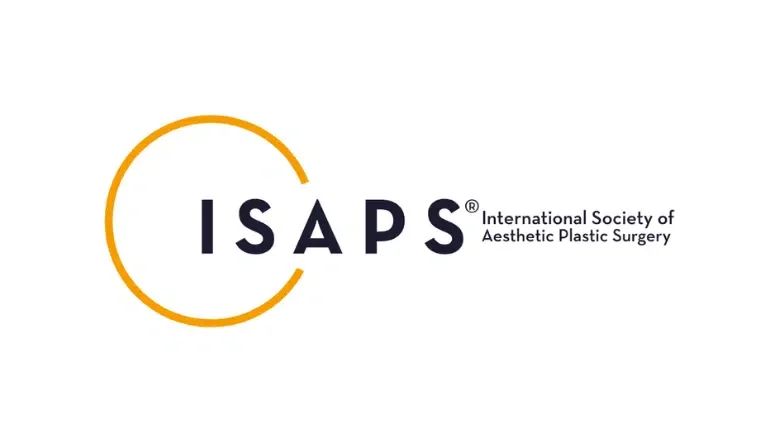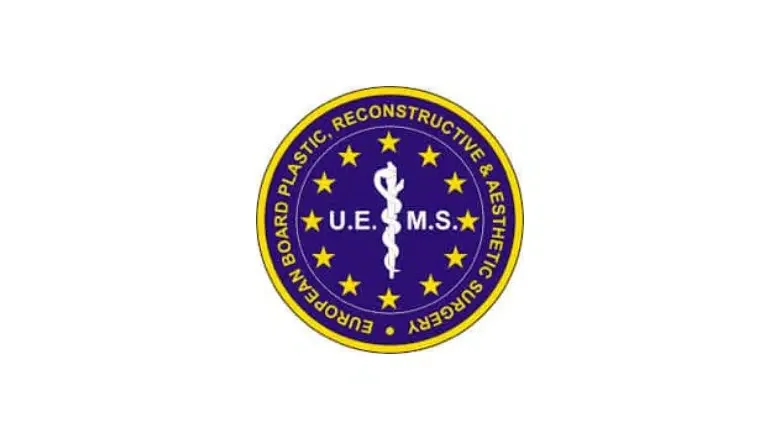Can I Have Hernia Repair and a Tummy Tuck at the Same Time?
If you’ve got a hernia in your tummy area, you might be wondering if you can fix it while also getting a tummy tuck or mini tummy tuck for a better look. The simple answer is yes, you can! A plastic surgeon can take care of your hernia while also making sure your tummy looks great afterwards.
In more detail, a hernia happens when something inside your body, like part of your intestines or some fat, pokes through a weak spot in your tummy muscles. These muscles can get weak for different reasons, like if you’ve been pregnant before or if you’re carrying extra weight.
You can even take it a step further and have your tummy tuck include repair work on ‘diastasis recti’, which is just a fancy term for tummy muscles that have split apart. This can make your tummy muscles stronger and give you a smoother, flatter belly.
Here at Centre for Surgery in London, our team are experts in reshaping bodies, and we’ve got lots of experience with fixing tummy walls and diastasis recti. Our surgeons use really precise methods and the latest stitching techniques to make sure you’re not just fixed up, but you also look your best when it’s all done.
RELATED: Tummy Tuck with Muscle Repair
Abdominoplasty vs Hernia Repair Surgery
When it comes to surgical procedures aimed at enhancing bodily function and aesthetic appeal, abdominoplasty and hernia repair surgery stand out for their distinct purposes and outcomes. Abdominoplasty, commonly referred to as a tummy tuck, is a cosmetic procedure designed to refine and rejuvenate the abdominal region. It’s particularly favoured by those desiring to reshape their body’s contour following significant weight loss or the transformative process of pregnancy. The essence of this procedure lies in its ability to sculpt the abdomen, achieving a more toned and aesthetically pleasing appearance. This is accomplished through the removal of stubborn excess skin and fat that remain unresponsive to traditional weight loss methods, such as diet and exercise, coupled with the tightening of abdominal muscles to enhance the abdominal profile.
In contrast, hernia repair surgery, medically known as herniorrhaphy, addresses the medical condition of hernias—where an organ or fatty tissue squeezes through a weak spot in a surrounding muscle or connective tissue called fascia. Hernias can emerge in various parts of the body but are most commonly seen in the abdominal area. They can lead to discomfort, pain, and other health complications if left untreated. The primary aim of hernia repair surgery is to reposition the displaced tissues back into their correct place and fortify the muscle or tissue wall to avert future occurrences. This surgical intervention is pivotal in alleviating the symptoms associated with hernias, thereby improving the patient’s quality of life.
The decision to undergo a combined surgery that includes both abdominoplasty and hernia repair presents a strategic approach to patient care. This amalgamation serves multiple benefits, including the efficiency of addressing two significant concerns in one surgical session, enhancing the effectiveness of the treatment, and offering the convenience of a single recovery period. Such a combined procedure also means patients undergo anaesthesia once, reducing overall recovery time and potential risks associated with multiple surgeries.
What is a Hernia?
A hernia is when a part of your body, like your intestines or a bit of fat, squeezes through a weak spot in your muscles or the tissue that holds your organs in place. You’ll often notice it as a bump or lump that pops up in your tummy or groin area. This lump is more noticeable when you’re doing something that puts pressure on your abdomen, like coughing or lifting something heavy. The lump might go away or become less noticeable when you lie down.
RELATED: What is a hernia and how can it be repaired?
Both kids and adults can get hernias. For children, hernias usually don’t cause any problems except for a lump that doesn’t hurt. But for adults, symptoms can be a bit more bothersome:
- You’ll see a lump that disappears when you lie down.
- The area around the lump might become red, tender, or swollen.
- You might feel some pain or discomfort near the lump.
- You could have trouble going to the toilet or passing gas.
- These symptoms could get worse when you’re standing or straining yourself.
- In some cases, you might even vomit.
When it comes to treating hernias, a general surgeon or a plastic surgeon usually takes care of it. At Centre for Surgery clinic in London, we often fix hernias as part of other body-shaping procedures like a tummy tuck. But if you’re more concerned about how the hernia area will look after surgery, a plastic surgeon can do the hernia repair on its own to get the best cosmetic result.
RELATED: Split Tummy Muscles after Pregnancy – Treatments for Diastasis Recti
Exploring the Various Kinds of Hernias: An In-depth Look
Hernias can manifest in various parts of the body, particularly in the abdomen and groin regions. The type of hernia you have depends on where exactly the lump or bulge shows up. Let’s dive into more detail on the different kinds of hernias and how they can affect you.
Types of Hernias
Ventral Hernias
Ventral hernias are those that occur in the abdomen. These happen when tissue from inside your abdomen, like an organ or abdominal tissue, pushes through a weakened spot in the abdominal muscle wall. There are different sub-types of ventral hernias, such as:
- Epigastric Hernias: These are situated between your navel and the lower part of your breastbone. They usually consist of fatty tissue protruding through a weak point in the abdominal muscles.
- Umbilical Hernias: This type of hernia is particularly focused around the belly button. It occurs when a part of your intestines protrudes through a weak point or hole in the muscles near your umbilicus (the medical term for the belly button).
- Incisional Hernias: These happen at the site of a previous surgical wound in the abdomen. The tissue around surgical stitches can be weaker than other areas, making it more prone to herniation as time goes on.
Inguinal and Femoral Hernias
These hernias are more commonly found in the groin area. Here’s what sets them apart:
- Inguinal Hernias: More commonly found in men, these hernias appear when part of the intestines descends, creating a bulge in the groin region.
- Femoral Hernias: These are more common in women and happen when a part of the bowel or fatty tissue squeezes through the wall of the femoral canal, which is near the groin.
Epigastric Hernias
Sometimes called midline hernias, these occur when fatty tissues push their way through the abdominal wall, specifically in the area between your belly button and the lower part of your breastbone.
Diastasis Recti
Though not strictly a hernia, diastasis recti is a condition that is often seen after pregnancy. The stretched abdominal muscles become separated down the middle, allowing for fat or intestines to poke through the gap.
Incisional or Surgical Wound Hernias
When you have a surgical procedure done on your abdomen, the spot where the incision was made can become a weak point. Because the tissue that has been stitched back together is weaker than natural tissue, there’s an increased risk of a hernia developing at that site over time.
Why Do People Get Hernias?
Hernias usually happen when there’s a combination of muscle weakness and some sort of strain or pressure on those muscles, particularly in the abdominal area. Let’s look at what specifically contributes to this condition.
Causes of Increased Pressure on Abdominal Muscles
- Obesity or Being Overweight: Carrying extra weight increases the pressure on the abdominal muscles, making them more prone to hernias.
- Persistent Cough: A heavy, ongoing cough can put continuous pressure on these muscles, causing them to weaken over time.
- Multiple Pregnancies: Having twins or triplets puts a lot of strain on the abdominal area, stretching the muscles and increasing the risk of hernias.
- Heavy Lifting or Straining: Activities that put excessive strain on your muscles, like lifting heavy objects, can also contribute to hernias.
Umbilical and Epigastric Hernias: The Mystery Factors
It’s often hard to pin down the exact cause of umbilical and epigastric hernias. However, the key risk factors usually include having been pregnant before and being overweight.
The Role of Pregnancy: Diastasis Recti
During pregnancy, the abdominal muscles have to stretch to accommodate the growing baby. This is particularly true for the rectus abdominis muscles, the vertical muscles at the front of your stomach often referred to as the “six-pack abs.”
RELATED: Abdominal Separation – Diastasis Recti after Pregnancy
After giving birth, these muscles usually go back to their original position. However, in some cases, they lose their elasticity and can’t close the gap that was created during pregnancy. This condition is known as diastasis recti or diastasis rectus abdominis. A tummy tuck, or abdominoplasty, can help repair this condition.
The Common Cases in Tummy Tuck Procedures
Both umbilical and midline hernias can often be treated during a tummy tuck procedure. In these cases, part of the intestine or fatty tissue pushes through weakened abdominal muscles, typically around the area of the navel. This creates a bulge that can be both unsightly and uncomfortable.
Each type of hernia and its causes have unique considerations, and the treatment options will vary. Therefore, it’s crucial to consult healthcare professionals for a proper diagnosis and to discuss the best treatment for you.
Understanding the Risks: What Could Go Wrong with a Hernia?
Having a hernia isn’t just uncomfortable; it can lead to serious complications if not treated in time. Let’s go over some of the issues that can arise from epigastric or umbilical hernias:
Strangulation and Incarceration
- Incarceration: This happens when a portion of the bowel that’s sticking out becomes trapped and can’t be pushed back into the abdomen. Symptoms include abdominal pain, nausea, and vomiting.
- Strangulation: This is a more severe form of incarceration where the protruding section of bowel gets cut off from its blood supply. When this happens, the affected tissue can suffocate and die, leading to life-threatening complications.
Infections and Life-Threatening Situations
When tissue dies due to strangulation, it’s not just a local issue. This can cause infections that may rapidly spread throughout the abdomen, creating a life-threatening situation that requires immediate medical attention.
Why Surgical Intervention is Recommended
Most adult hernias won’t heal on their own; they typically need surgical intervention. This is why hernia repair surgery is often recommended. During the surgery, the protruding tissue is put back where it belongs, and the weak spot in the muscle wall is reinforced, usually with stitches or sometimes with a mesh.
Tummy Tuck and Hernia Repair: A Combined Approach
If you’re already planning a tummy tuck procedure, and your surgeon discovers an undiagnosed hernia, they will usually recommend fixing it during the same surgery. Addressing both issues at once not only enhances the aesthetic outcome but also minimises future health risks. Of course, this would be thoroughly discussed with your surgeon prior to the abdominoplasty procedure.
Opting for a Combined Tummy Tuck and Hernia Repair: What You Need to Know
Getting a hernia repaired at the same time as having a tummy tuck can offer several benefits. Both procedures involve work on the abdominal muscles, making them a natural pairing in many cases. Here’s what you can expect if you’re considering combining these surgeries.
Synergistic Procedures
A tummy tuck—medically known as abdominoplasty—is primarily a cosmetic surgery that removes excess fat and skin from your abdomen, giving it a toned and slimmer appearance. On the other hand, hernia repair focuses on the functional aspect of fixing a weakened muscle wall to prevent intestines or fatty tissue from protruding.
Since both surgeries involve strengthening the abdominal muscles, it makes sense to consider having them done together. This allows your surgeon to take a comprehensive approach, addressing both aesthetic and functional issues in a single surgical session.
Hidden Hernias: The Element of Surprise
Interestingly, some hernias might not even be noticeable until a tummy tuck procedure is underway. Extra layers of fat and skin can sometimes obscure a hernia, making it visible only once the surgeon has removed the excess tissue. This is another reason why opting for a surgeon experienced in both tummy tucks and hernia repairs is beneficial—they’ll know what to look for and how to address it should an unexpected hernia appear.
The Surgical Approach: A Two-in-One Solution
An expert surgeon will first focus on repairing the hernia, which involves pushing the protruding tissue back into its correct position behind the abdominal wall. Once this is done, they will also address any diastasis recti—separation of the abdominal muscles—before proceeding with the tummy tuck. This multi-step approach ensures that your abdominal muscles are both functionally sound and aesthetically pleasing.
Exploring Your Options for Hernia Repair Surgery
There are various surgical methods available to you for hernia repair. The choice often depends on the type and location of your hernia, as well as any other abdominal issues you may want to address simultaneously, such as loose skin or separated abdominal muscles. Here’s a more in-depth look at the types of hernia repair surgeries:
1. Open Hernia Surgery
What Happens During the Procedure
- The surgeon begins by making a small incision either at the base of your belly button or above it, based on the location of the hernia.
- The next step involves pushing the protruding intestine or fatty tissue back into its original place inside the abdomen.
- The surgeon then focuses on strengthening the weakened abdominal muscles. This is done either by stitching the muscles together or by using a special mesh patch for larger hernias. The mesh patch can also help in rectifying separated abdominal muscles, known as diastasis rectus abdominis.
- The surgery concludes with the surgeon using dissolvable stitches and meticulous suturing techniques to close the incisions.
Time and Anaesthesia
- The procedure generally takes around 30 minutes.
- It is performed under general anaesthesia, so you won’t feel any pain during the surgery.
2. Combined Tummy Tuck and Hernia Repair Surgery
What Happens During the Procedure
- The procedure starts with a horizontal incision near the bikini line, extending from one hip bone to the other.
- The surgeon detaches the skin from the umbilicus (belly button) and separates the fatty tissue and skin from the underlying muscle layer, lifting the skin up towards the breastbone.
- Next, any existing hernias are pushed back into their original position. If you have diastasis recti, it is repaired using robust sutures, thus improving the contour and integrity of your abdominal muscles.
- Excess skin and fat are then pulled down and tightened, and the extra tissue is removed to create a flatter and smoother abdomen.
- Specialised suturing techniques are used for closing the incisions to minimise scarring.
RELATED: What is Diastasis Recti and how can I fix it?
Time and Anaesthesia
- This combined procedure takes approximately two to two and a half hours.
- It is also performed under general anaesthesia.
3. Laparoscopic Hernia Surgery (Not Offered at Centre for Surgery)
What Happens During the Procedure
- The surgeon makes several small incisions near the navel to insert a laparoscope—a thin tube with a camera attached.
- Your abdomen is inflated with carbon dioxide gas to create space, making it easier for the surgeon to see and work.
- The herniated tissue is pushed back into the abdomen.
- Finally, a mesh patch is attached to the surrounding tissue to strengthen the abdominal wall and prevent future hernias.
Advantages
- This is a minimally invasive procedure, resulting in almost invisible scars.
Why Opt for a Plastic Surgeon for Your Hernia Repair: A Comprehensive Rationale
While general surgeons are adept at handling abdominal hernias, opting for a plastic surgeon, especially from a specialised centre like Centre for Surgery, can provide distinct advantages. These benefits span from the aesthetic to the practical, ensuring that you receive a comprehensive treatment that addresses your condition’s functional and cosmetic aspects.
Expertise in Delicate Procedures
- Refined Incisions: Plastic surgeons are trained to make precise, small incisions that heal better and are less noticeable.
- Aesthetic Suturing: The suturing techniques employed by plastic surgeons are designed not just to hold tissue together but to do so in a way that is aesthetically pleasing and minimises scar visibility.
- Less Scarring: Due to their training in cosmetic procedures, plastic surgeons use techniques that result in minimal scarring, enhancing the overall cosmetic result.
Comprehensive Treatment
- Dual Expertise: Unlike general surgeons, a plastic surgeon can concurrently perform both a hernia repair and a tummy tuck (abdominoplasty). This dual approach addresses both functional and cosmetic issues in a single surgery.
- Single Recovery Period: Combining procedures means you’ll only need to undergo anaesthesia once and will have a single recovery period, making the process more efficient and potentially reducing the risks associated with multiple surgeries.
- Holistic Repair: During the same surgical session, a plastic surgeon can correct a range of issues such as diastasis recti, protruding hernia, excess fat, and sagging skin, providing a comprehensive treatment plan tailored to your needs.
Specialised Care
Centre for Surgery specialises in plastic surgery, meaning the surgeons have specific expertise in complicated reconstructive procedures, making them well-equipped to handle even the most complex hernia cases.
Frequently Asked Questions About Tummy Tuck and Hernia Repair Surgery
What are the primary advantages of combining a tummy tuck with hernia repair surgery?
Combining a tummy tuck, or abdominoplasty, with hernia repair surgery brings forth multiple advantages, streamlining the patient’s surgical journey. One of the key benefits includes undergoing a single recovery phase, which significantly reduces the overall downtime compared to having two distinct surgeries at different times. This amalgamation can also lead to a reduction in the total cost, as patients only need to pay for anaesthesia and facility fees once. Moreover, this combined approach allows for both functional and cosmetic enhancements to be achieved simultaneously. Patients can look forward to not only correcting the hernia, which may be causing discomfort and health issues, but also enhancing the appearance of their abdominal area, resulting in a more toned and contoured silhouette.
How can I determine if I am a good candidate for the combined procedure?
Determining suitability for the combined surgery is a multifaceted process that hinges on various factors, such as your overall health condition, the type and severity of the hernia present, and your cosmetic aspirations concerning abdominoplasty. Generally, ideal candidates are those in good health, have a stable weight, and possess a dual requirement—a hernia needing repair and a desire for an improved abdominal profile. A thorough assessment by a surgeon, including an assessment of your medical history, current health status, and surgical objectives, is essential to ascertain if this combined surgical approach is the most beneficial for you.
Do I need to get my hernia sorted out straight away?
Not all hernias need immediate attention, especially if they’re small and not causing any discomfort. However, as time goes on, most hernias will get bigger and could lead to serious health issues. That’s why doctors usually recommend surgery for adults with hernias, to sort out the problem before it gets worse.
What’s the best method for fixing a hernia?
In most cases, the go-to method for sorting out a hernia is surgery. There are different ways this can be done. For example, laparoscopic surgery involves making a few small cuts and using a camera to guide the operation, whereas open repair surgery involves a larger incision. Another option is to combine the hernia repair with a tummy tuck if you’re looking to improve both how your stomach functions and how it looks. A skilled surgeon at Centre for Surgery will advise you on the best approach for your specific needs.
Is it normal to feel a lump after my hernia repair operation?
Yes, feeling a lump-like sensation after a hernia repair operation is fairly common. What you’re probably feeling is swelling or fluid that has built up around the area where the surgery was done. As you recover, this swelling should reduce, and you’ll notice the lump diminishing day by day. So, don’t be too worried; it’s a part of the healing process.
What does the recovery process look like for combined abdominoplasty and hernia repair?
The recovery phase following a combined abdominoplasty and hernia repair surgery requires a period of rest and limited physical activity to foster optimal healing. Patients may experience a range of post-operative symptoms, including discomfort, swelling, and bruising, all of which can be effectively managed with medication prescribed by your surgeon. You will receive detailed instructions on how to care for the surgical site, recommendations for your diet, and guidelines on activity levels to adhere to during the recovery period. The duration of the recovery varies among individuals but is generally longer than that for a single procedure due to the comprehensive nature of the combined surgeries.
Are there any increased risks associated with combining these two surgeries?
While the efficiency of combining a tummy tuck and hernia repair surgery is appealing, it is important to acknowledge that this approach may introduce an increased complexity to the procedure. Such complexity can slightly elevate the risk of complications, including infections or the development of blood clots. Nonetheless, selecting an experienced surgeon and following proper pre-operative and post-operative care protocols significantly mitigates these risks. Engaging in an open and informative discussion with your surgeon about all potential risks and how they are managed is crucial prior to undergoing the surgery.
What should I look out for if my hernia repair hasn’t worked?
If your hernia repair has failed, there are some specific symptoms to be aware of. These include intense pain that won’t go away even after taking the painkillers your doctor prescribed. You might also experience a fever and feel sore or tender near the cut where the surgery was performed. Other warning signs could be vomiting and constipation. This is why it’s crucial to pick a skilled surgeon for your operation. An experienced medical professional will be able to spot and help prevent these complications.
Can I get liposuction done while I’m having my hernia fixed?
It might be possible to have liposuction done at the same time as your hernia repair. However, this is something your plastic surgeon will need to evaluate. They’ll look at how big your hernia is and the specific parts of your tummy where you want to remove fat. Only after this assessment will they be able to make an informed decision about combining the two procedures.
Why Choose Centre for Surgery for Your Tummy Tuck Procedure?
When it comes to rejuvenating your appearance and improving your well-being, choosing the right clinic is a crucial decision. At Centre for Surgery, we pride ourselves on offering the highest standard of care, personalised treatments, and world-class expertise. Here are compelling reasons why Centre for Surgery should be your go-to clinic for a tummy tuck procedure:
Expertise You Can Trust
Our surgeons are renowned experts in the field of plastic surgery and have years of experience in both tummy tuck procedures and hernia repairs. Their extensive knowledge ensures that you are in the safest hands.
State-of-the-Art Facilities
Our clinic is equipped with cutting-edge technology and adheres to the highest standards of hygiene and safety. Our modern operating rooms provide a sterile environment for a seamless surgery experience.
Comprehensive Consultation
Your journey begins with a thorough consultation, where our surgeons take the time to understand your individual needs, medical history, and aesthetic goals. This allows us to develop a personalised treatment plan tailored specifically for you.
Dual Procedures
We specialise in performing tummy tuck and hernia repair simultaneously, providing you with both functional and aesthetic benefits. This means you only need to go through one anaesthesia and one recovery period, making the process more convenient for you.
Exceptional Aftercare
Our commitment to your well-being doesn’t end after the surgery. We offer excellent aftercare services, including regular follow-up appointments to monitor your recovery and ensure optimum results.
What Our Patients Say
“My experience at Centre for Surgery was phenomenal. Not only did my tummy tuck turn out beautifully, but the care I received was beyond my expectations. I felt like I was in the best hands from start to finish.”
— Emily J.
“I couldn’t be happier with the results and the overall experience. The surgeons are highly skilled, and the staff were incredibly supportive throughout the entire process.”
— Mark T.
“Choosing Centre for Surgery was the best decision I ever made. I had a tummy tuck and hernia repair done at the same time, and I couldn’t believe how smooth the entire process was.”
— Sarah L.
To find out more or to schedule a consultation, you can reach us through the following channels:
📞 Phone: 0207 993 4849
📧 Email: contact@centreforsurgery.com
📍 Address: 95-97 Baker Street, London W1U 6RN
We look forward to helping you achieve your aesthetic and health goals. Choose Centre for Surgery for a life-changing experience you won’t regret!
